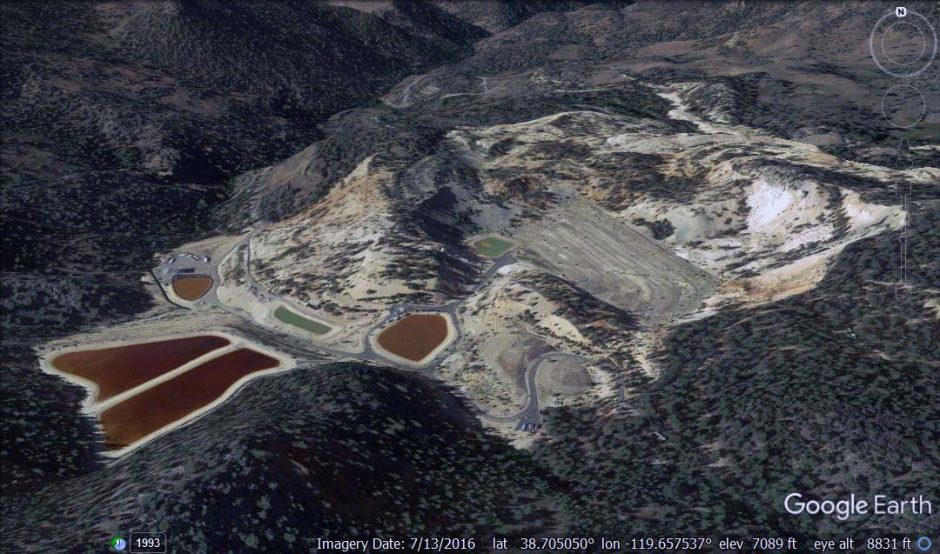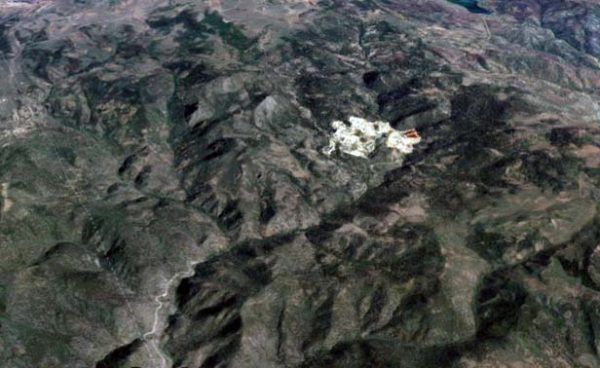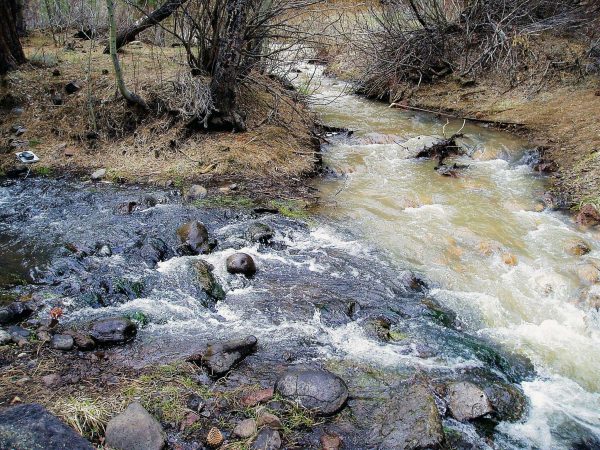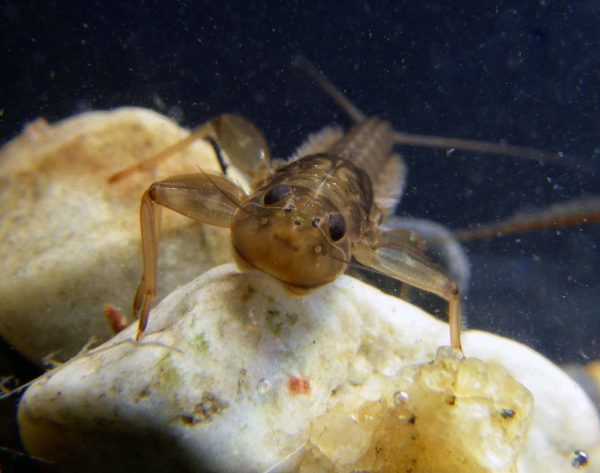Insects Show the Healing of Toxic Metal Mining Scars

Overview of the open pit mine. (Credit: Google Earth, via source)
A hue reminiscent of orange soda might be appealing at the diner, but in rivers and streams, it’s a sign of serious damage. Open pit mining, which excavates strategic minerals from huge open pits dug into the land, is particularly harmful to the environment, exposing metallic dust, radioactive elements, and other potentially toxic contaminants. These tailings can easily leach into groundwater and streams.
To deal with the damage caused by open pit mines across the country teams employ various remediation techniques, depending on the specifics of the particular mine and location in question. And although experts target remediation efforts as carefully as possible, it’s not always clear whether cleanup efforts in streams and rivers are successful.
Now, recent research from the Sierra Nevada Aquatic Research Laboratory (SNARL), part of the University of California system, and the US Environmental Protection Agency reveals that benthic invertebrates—the insects that dwell underneath the rocks of streams and rivers—offer a unique insight into remediation efforts after open pit mining has damaged an ecosystem. Dr. David Herbst, lead author and head of the Herbst Lab at the University of California, Santa Barbara (UCSB), spoke to EM about the research.
The trouble with open pit mining and contamination
Although there are only a handful of long-term studies on open pit mining in the US, it is a common and persistent environmental problem.
“The number of open pit mines and metal contamination sites in the United States is really pretty mind-boggling, and metal contamination isn’t just at sites where there’s been mining,” explains Dr. Herbst. “Some of it occurs at sites where minerals and poisonous metals have been processed or used to carry out processing. In the Sierra Nevada, for example, there are many streams that have mercury contamination that originates elsewhere, brought in to those locations for processing gold in the mountains of California. A lot of nasty metals have been spread around.”

A view of the impacted stream drainage from the mine on the right (Leviathan Creek), and the natural stream drainage on the left (Mountaineer Creek), used for most comparisons of health over time. Credit: (Google Earth, via source.)
The recent paper from Herbst and the SNARL/EPA team reports on 18 years, and they are now in their 21st year of monitoring in the area.
“It has been really instructive to be able to collect that data for that long a period of time, to be able to track the long-term successes of these projects,” comments Dr. Herbst. “Because it takes so long to fix this kind of contamination, you really need long-term data to get at what works, where, when, and how, in order to be prescriptive for other mines that have similar kinds of problems.”
The Leviathan mine is worse off than many other open pit mines because the actual mineral that was mined there was sulfur—the real culprit when it comes to producing the dilute sulfuric acid that occurs when you expose soils by mining.
“The sides of the pit are so steep that it’s hard to grow anything, and it just continues to crumble and erode and expose the ore body,” remarks Dr. Herbst. “Even inadvertently exposing sulfur creates this acidity, but in this case, the actual orebody was sulfur, so it’s extra problematic from the standpoint of creating this acid mine drainage. It then picks up other toxic metals, dissolves them, and carries those into streams. That’s the real problem at Leviathan.”
It’s this issue that causes the tell-tale, bright orange runoff in streams near these mines.
“When you expose a lot of these ore-containing bodies, you’re often exposing the sulfur as well,” Dr. Herbst describes. “It then oxidizes and forms the dilute sulfuric acid as well as this nasty stuff they call Yellow Boy, which is actually an orange color. Yellow boy occurs when iron minerals become oxidized and form what looks like rust. Streams kind of run this orange color that looks almost like paint. It’s nasty, nasty stuff.”
Developing best practices—and solutions
Open pit mining has many ecological drawbacks, and there is no clear way to ensure that every site will be completely restored. Credit for the clean-up efforts goes to the Lahontan Regional Water Board and staff (state of California), US EPA, Atlantic Richfield and its contractors, all working in collaboration on the site to fix the impacts of mining that occurred at Leviathan over 50 years ago. Experts like the SNARL team are working to help them show progress and find quicker, more effective, less costly ways to help ecosystems recover from the extraction of strategic minerals.
“Our study informs how to fix the problem, because we’re looking at different kinds of mining remediation practices, and whether they produce healthy aquatic life” adds Dr. Herbst.
In fact, they’re evaluating two practices: a chemical treatment and a biological treatment.
“Two creeks run off the open Leviathan mine site: Leviathan Creek and Aspen Creek,” explains Dr. Herbst. “On the Leviathan creek side, ponds catch toxic flows draining from old mining shafts or adits and prevent the water from flowing all the way to Leviathan Creek. The contents of those ponds are then pumped into tanks that act like a chemical reactor, where calcium oxide is added to neutralize the pH and bring it back up. This precipitates out a lot of the minerals and nasty metals that are in the solution, and that forms a sludge on the bottom of those tanks, and the cleansed, overlying water can then be released back into the stream.”

A decent example of what these flows look like at the confluence of an intact stream coming in on the left (Mountaineer Creek), and one draining the mining metals with yellow-orange iron deposits on the rocks on the right (Leviathan Creek). This is a good example of what it’s looked like in the past, and that this difference has been eliminated for the most part at this point in ongoing clean-up of the site. (Credit: David Herbst)
The Aspen Creek side employs the biological treatment.
“Instead of using that chemical treatment, they use a big, rock-lined wetland in which there are bacteria that live that reduce sulfate,” details Dr. Herbst. “These sulfate-reducing bacteria essentially reverse the whole process that causes the oxidation of the sulfur in the first place. As a consequence, they bring the pH back up and precipitate out the toxic metals that are in the solution. That sludge then sinks to the bottom of the wetland which then releases the cleansed water back into the creek.”
The team’s long-term monitoring and studies reveal the relative success and combination of success with those two types of treatments depending on the nature of the problem and the volume of flow that needs to be treated. An increase in the number and variety of invertebrate life forms over time has shown progress in the capture and treatment of polluted water.
“I think the bottom line of all this is that these treatment processes are working,” adds Dr. Herbst. “They’re recovering life in the stream, and there’s really a reason to feel that this was a successful means of fixing the problem. I think this should provide important instruction to other projects that have these kinds of problems. What we’re giving is the biological endpoint of whether or not all the work they’re doing is showing progress and showing success in recovering the ecological values of the stream.”
The team observed that in many cases, despite gains from treating contaminated streams during the summer months this was lost over the winter when the sites were less accessible.
“There is this recovery and relapse that happens annually,” comments Dr. Herbst. “It’s been two steps forward, one step back, year after year, and ultimately the sites that are furthest from the mine have now reached a natural intact state, whereas those that are closer to the mine haven’t and the problem may continue to fall behind. If they’re able to either continue these treatments or, better yet, figure out a way to do year-round treatment, we ought to see a full recovery of the stream.”
Looking ahead
Dr. Herbst and the other researchers are hoping that their work will help the public see benthic insects as powerful tools we can use to monitor the health of our environment.

A mayfly (genus Ironodes) that is very sensitive to the effects of acid mine drainage. (Credit: Bruce Medhurst)
“There’s been a lot of attempts in the literature lately to place economic values on the ecological services that are provided by things like bugs,” muses Dr. Herbst. “Bugs are little garbage collectors; they ultimately are consuming algae and decomposing organic matter in the streams. Without them, water quality declines, with low dissolved oxygen and toxicants released into the water. As long as we keep the bugs in the stream healthy and don’t overwhelm them with pollutants, then they will continue to provide us with this service that we otherwise have to build a water treatment plant and pay for. So it’s wise for us to take care of these little creatures and think about them a lot because they’re telling the story of recovery from pollution.”
This can mean getting past a human prejudice against insects—and developing a curiosity that motivates you to turn over a few stones.
“If you go to a stream and you turn over a rock the reaction you get from some people is, ‘Ew, yuck, there’s a bug!’” quips Dr. Herbst. “But the proper response is, ‘Oh, that’s great, I’m glad there’s life there,’ because if there’s no life living under that rock, you have reason to believe there’s something wrong with that water.”
The ultimate takeaway for Dr. Herbst and the team? That even massive, complex problems can be solved with perseverance, the right data, and a level of attention.
“Even big, daunting problems like this show that the landscape can be resurrected,” remarks Dr. Herbst. “That’s not to say that Leviathan is fixed; it’s to say that the treatment is working. The patient is up off the table and is once again starting to thrive.
“That’s really what I hope comes out of this, I hope it encourages people not walk away from these problems, and to really go out there and try to tackle them, even though they may take many years to solve,” adds Dr. Herbst.
Top image: Overview of the open pit mine. (Credit: Google Earth, via source)




0 comments